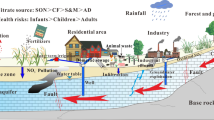Abstract
The identification of sources and behavior of contaminants is important to control and manage groundwater quality of aquifer systems in urban areas. In this study, hydrogeochemistry of major constituents and stable isotope ratios of nitrate in groundwater were determined to identify contamination sources and transformation processes occurring in soils and deeper groundwater of Beijing with intense human activities. The nitrogen and oxygen isotopic compositions of nitrate in pore water extracts from groundwater samples indicate at least three potential sources of nitrate in groundwaters at Beijing. Stable isotope analyses from this study site, which has atmospheric, chemical fertilizer and human waste nitrate sources, provide a tool to distinguish nitrate sources in a confined aquifer where concentrations alone do not. These data indicate that the most common sources of high nitrate concentrations in groundwater at Beijing are wastewater and denitrification process occurred specially in the Central area. NO3–N and cation and anion concentrations (Ca2+, Mg2+ Cl− and SO 24 ) showed strong correlations indicating that they originated from the same sources. This study demonstrates that a thorough evaluation of hydrodynamic and hydrochemical parameters with dual isotopes of NO3 − constitutes an effective approach for identifying sources and transformation processes of NO3 − in deeper groundwater systems.







Similar content being viewed by others
References
Babiker IS, Mohamed AA, Terao H et al (2004) Assessment of groundwater contamination by nitrate leaching from intensive vegetable cultivation using geographical information system. Environ Int 29:1009–1017
Böhlke JK, Denver JM (1995) Combined use of groundwater dating, chemical, and isotopic analyses to resolve the history and fate of nitrate contamination in two agricultural watersheds. Atlantic coastal plain, Maryland. Water Resour. Res. 31:2319–2339
Chen Z, Nie Z, Zhang Z et al (2005) Isotopes and sustainability of ground water resources, North China Plain. Ground Water 43(4):485–493
Cravotta CA (1997) Use of stable isotopes of carbon, nitrogen, and sulfur to identify sources of nitrogen in surface waters in the Lower Susquehanna River Basin, Pennsylvania, US geological survey, water supply paper 2497. US Geological Survey, Denver
Dennis ER, Graham EF, David LD, Dianne TL, Mark EG (1996) Nitrogen isotope ratios identify nitrate contamination sources. Calif Agric 50(2):32–36
Deutsch B, Mewes M, Liskow I et al (2006) Quantification of diffuse nitrate input into a small river system using stable isotopes of oxygen and nitrogen in nitrate. Org Geochem 37:1333–1342
EPA US (1997) “Integrated risk information system (IRIS)” data base access. U.S. Environmental Protection Agency. April (1997)
EPA US (2003) National primary drinking water standards EPA 816-F-02-013:2002. [displayed August 2003] Available at http://www.epa.gov/safewater/mcl.html # inorganiC
Karr JD, Showers WJ, Jennings GD (2003) Low-level nitrate export from confined dairy farming detected in North Carolina streams using d15N. Agric Ecosyst Environ 95:103–110
Kellman LM, Hillaire-Marcel C (2003) Evaluation of nitrogen isotopes as indicators of nitrate contamination sources in an agricultural watershed. Agric Ecosyst Environ 95:87–102
Kendall C (1998) Tracing nitrogen sources and cycling in catchments. In: Kendall C, McDonnell JJ (eds) Isotope tracers in catchment hydrology. Elsevier, Amsterdam, pp 519–576
Kross BC, Ayebo AD, Fuortes LJ (1992) Methemoglobinemia: nitrate toxicity in rural America. Am Fam Physician 46(1):183–188
Mande ASSL, Liu M, Gbandi DB et al (2011a) Evolution processes of groundwater quality in an urban area. Afr J Agr Res 6(6):1295–1302
Mande ASSL, Liu M, Gbandi DB et al (2011b) Hydrochemical investigation of groundwater contamination in an urban area of Beijing aquifer: impact of irrigation with industrial waste water. Afr J Agr Res 6(31):6555–6562
Mande ASSL, Liu M, Gbandi DB et al (2011c) Factor analysis as an example of qualitative and quantitative method for modeling Hydrogeochemical processes of coastal sedimentary basin of Togo. Afr J Microbiol Res 5(31):5554–5559
Mande ASSL, Liu M, Gbandi DB et al (2012a) Groundwater flow and contaminant transport modeling applications in urban area: scopes and limitations. Environ Sci Pollut Res. doi:10.1007/s11356-012-0744-0
Mande ASSL, Liu M, Gbandi DB et al (2012b) Nitrate in drinking water: a major polluting component of groundwater in gulf region aquifers, south of Togo. Int J Phys Sci 7(1):144–152
Marimon PCM, Knoller K, Roisenberg A (2007) Anomalous fluoride concentration in groundwater-is it natural or pollution? A stable isotope approach. Isotopes Environ Health Stud 43(2):165–175
Moore BK, Ekwurzel B, Bradley KE et al (2006) Sources of groundwater nitrate revealed using residence time and isotope methods. Appl Geochem 21:1016–1029
NRC (1981) The health effects of nitrate, nitrite, and N-nitroso compounds, national research council. National Academy Press, Washington
Rock L, Mayer B (2002) Isotopic assessment of sources and processes affecting sulfate and nitrate in surface water and groundwater of Luxembourg. Isotopes Environ Health Stud 38(4):191–206
Silva SR, Kendall C, Wilkison DH et al (2000) A new method for collection of nitrate from fresh water and the analysis of nitrogen and oxygen isotope ratios. J Hydrol 228(1–2):22–36
Townsend MA, Young DP, Macko SA (2003) Kanas case study applications of nitrogen-15 natural abundance method for identification of nitrate sources. J Hazard Subst Res 4:1–22
WHO (1996) Guidelines for drinking-water quality. In: Health Criteria and other supporting information, 2nd edn, Vol 2. World Health Organization, Geneva
Winton E, Tardiff R, McCabe L (1971) Nitrate in drinking water. J Am Water Works Assn 63:95–98
Zhang Y, Liu XJ, Fangmeier A et al (2008) Nitrogen inputs 87 and isotopes in precipitation in the North China Plain. Atmos Environ 42:1436–1448
Acknowledgments
This work was supported by the 863 Program (2007AA06A410) of the Chinese Ministry of Science and Technology and the studies of safety evaluation and pollution prevention technology and demonstration for groundwater resources in Beijing (D07050601510000) and supported by the Fundamental Research Funds for the Central Universities (2652013033).
Author information
Authors and Affiliations
Corresponding author
Rights and permissions
About this article
Cite this article
Mingzhu, L., Seyf-Laye, AS.M., Ibrahim, T. et al. Tracking sources of groundwater nitrate contamination using nitrogen and oxygen stable isotopes at Beijing area, China. Environ Earth Sci 72, 707–715 (2014). https://doi.org/10.1007/s12665-013-2994-7
Received:
Accepted:
Published:
Issue Date:
DOI: https://doi.org/10.1007/s12665-013-2994-7




